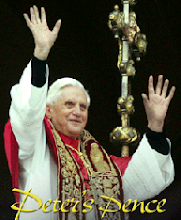
By Chiara Remondini and Flavia Krause-Jackson
Dec. 17 (Bloomberg) -- Pope Benedict XVI, who at 82 still handwrites his speeches rather than use a computer, is tapping YouTube, MySpace and podcasts to lure disenchanted youth into the Church’s fold.
Reaching out to the cyber-faithful, he this year debuted on YouTube, Google Inc.’s video-sharing site, and has a MySpace playlist that includes a rap song by Tupac Shakur. His midnight Christmas Mass next week will be podcast, and for the first time ever a Webcam will broadcast the Pope’s appearances from his apartment window overlooking St. Peter’s Square.
“New media will be increasingly important for the Church and the Pope himself has said the Internet is a tool,” Don Paolo Padrini, 36, a priest in the northern Italian village of Stazzano, said in an interview. “It demonstrates the Church isn’t afraid of technology and is keeping up with the times.”
Pope Benedict, who was elected in April 2005, is looking for ways to reach out to the young amid a decline in church attendance and following. Catholics were overtaken for the first time last year by the world’s 1.1 billion Muslims, according to the Vatican Statistical Yearbook. Attendance at Mass in the U.S. fell to 25 percent in 2002 from 75 percent in 1965, according to “Index of Leading Catholic Indicators: The Church since Vatican II” by Kenneth C. Jones.
“The new digital arena, the so-called cyberspace, allows (people) to encounter and to know each other’s traditions and values,” the Pope said in a May speech. It’s for “young people, who have an almost spontaneous affinity for the new means of communication to take on the responsibility for the evangelization of this ‘digital continent,’” he said.
‘Theoblogical’ Revolution
At least 100 people, including reporters and technicians, contribute to the Holy See’s Web efforts, Vatican spokesman Federico Lombardi said. From the www.pope2you.net Web site people can send Pope Benedict Christmas wishes. They can download a Facebook Inc. application that lets them listen to the Pope’s words, see his pictures and receive greetings from him through virtual postcards.
Religion-related Web sites, smart-phone applications including liturgies, groups on Twitter Inc. and other social networks and even a cross-shaped USB key are among signs people want to share ideas on their faith, nun Maria Trigila, one of the contributors to the book “Publishing, Media and Religion,” said in an interview.
“Religion-related Web sites are spreading like wildfire,” said Trigila. “We’re facing a ‘theoblogical’ revolution. The Church believes technology is one of the keystones for the future.”
Youth Trends
The Vatican, the world’s smallest state and home to the Pope, has flip-flopped between embracing new technologies and traditions, seeking to reach out to young generations without estranging older churchgoers.
In 2007, the Pope lifted a ban on celebrating Latin Mass in an effort to heal a 40-year-old spat with traditionalists, while a year later he took the online pseudonym ‘Bxvi’ in his first foray into Catholic forums in Internet chat rooms.
Emerging “spiritual” trends among young people include listening to religious podcasts, watching online videos and visiting Web sites of their churches, according to a February study by Ventura, California-based Barna Research Group.
Padrini, the Stazzano priest, set up a Webcam in his parish to broadcast Mass and had to open a second account on Facebook after reaching 5,000 friends.
‘Holy Trivia’
Padrini also masterminded iBreviary, an application for Apple Inc.’s iPhone, Research In Motion Ltd.’s Blackberry and other mobile phones with computer capabilities. He teamed up with Web developer Dimitri Giani to create an application containing hymns, psalms and prayers prescribed for each day, in five languages. It was the first application to obtain the Vatican’s approval, Giani said.
“Younger generations go to the Internet to get what they need,” Padrini said.
Giani is working on “Holy Trivia,” a video game with quizzes on the Bible and religious matters to approach the sacred texts in an “instructive and enjoyable” way. He said he plans to submit the video-game application to Apple for approval in coming weeks.
“Demand for iPhone applications is very high, but in the religion field there is still a lot to do,” Giani said.
The Web 2.0, or the second generation of the World Wide Web focusing on interactive and shareable content, may foster new links with the faithful.
Digital Rosary
The digital rosary, where a leading voice accompanies the recitation of the prayer, was unveiled last month and presented as the social network of prayer.
“A year ago, the electronic rosary was developed, a small device that even I carry with me in the car,” Archbishop Giovanni Tonucci said in a statement. “It was a success, so we decided to open up to new horizons through mobile phones.”
Barcelona-based industrial designer Gerard Moline developed the USB lab, which has the double functionality of a cross and key drive and “symbolizes the adaptation to the social and cultural changes in the information age,” he said.
The Vatican’s efforts to tap digital technologies go back to the 1990s. As his health began to fail, Pope John Paul II started the official Vatican Web site in 1995 and sent text messages to Catholic subscribers to his weekly Angelus prayer. The late pontiff also called the Internet a tool to “promote justice and solidarity.”
The Vatican’s Internet TV channel, meanwhile, offers “news coverage of the main activities of the Holy Father and Vatican events” and has 19,600 subscribers and more than 2.1 million total video views, according to the Web site.
“You must find new ways to spread voices and images of hope through the ever evolving communication system that surrounds our planet,” Pope Benedict said this year.
Taken from Bloomberg
Dec. 17 (Bloomberg) -- Pope Benedict XVI, who at 82 still handwrites his speeches rather than use a computer, is tapping YouTube, MySpace and podcasts to lure disenchanted youth into the Church’s fold.
Reaching out to the cyber-faithful, he this year debuted on YouTube, Google Inc.’s video-sharing site, and has a MySpace playlist that includes a rap song by Tupac Shakur. His midnight Christmas Mass next week will be podcast, and for the first time ever a Webcam will broadcast the Pope’s appearances from his apartment window overlooking St. Peter’s Square.
“New media will be increasingly important for the Church and the Pope himself has said the Internet is a tool,” Don Paolo Padrini, 36, a priest in the northern Italian village of Stazzano, said in an interview. “It demonstrates the Church isn’t afraid of technology and is keeping up with the times.”
Pope Benedict, who was elected in April 2005, is looking for ways to reach out to the young amid a decline in church attendance and following. Catholics were overtaken for the first time last year by the world’s 1.1 billion Muslims, according to the Vatican Statistical Yearbook. Attendance at Mass in the U.S. fell to 25 percent in 2002 from 75 percent in 1965, according to “Index of Leading Catholic Indicators: The Church since Vatican II” by Kenneth C. Jones.
“The new digital arena, the so-called cyberspace, allows (people) to encounter and to know each other’s traditions and values,” the Pope said in a May speech. It’s for “young people, who have an almost spontaneous affinity for the new means of communication to take on the responsibility for the evangelization of this ‘digital continent,’” he said.
‘Theoblogical’ Revolution
At least 100 people, including reporters and technicians, contribute to the Holy See’s Web efforts, Vatican spokesman Federico Lombardi said. From the www.pope2you.net Web site people can send Pope Benedict Christmas wishes. They can download a Facebook Inc. application that lets them listen to the Pope’s words, see his pictures and receive greetings from him through virtual postcards.
Religion-related Web sites, smart-phone applications including liturgies, groups on Twitter Inc. and other social networks and even a cross-shaped USB key are among signs people want to share ideas on their faith, nun Maria Trigila, one of the contributors to the book “Publishing, Media and Religion,” said in an interview.
“Religion-related Web sites are spreading like wildfire,” said Trigila. “We’re facing a ‘theoblogical’ revolution. The Church believes technology is one of the keystones for the future.”
Youth Trends
The Vatican, the world’s smallest state and home to the Pope, has flip-flopped between embracing new technologies and traditions, seeking to reach out to young generations without estranging older churchgoers.
In 2007, the Pope lifted a ban on celebrating Latin Mass in an effort to heal a 40-year-old spat with traditionalists, while a year later he took the online pseudonym ‘Bxvi’ in his first foray into Catholic forums in Internet chat rooms.
Emerging “spiritual” trends among young people include listening to religious podcasts, watching online videos and visiting Web sites of their churches, according to a February study by Ventura, California-based Barna Research Group.
Padrini, the Stazzano priest, set up a Webcam in his parish to broadcast Mass and had to open a second account on Facebook after reaching 5,000 friends.
‘Holy Trivia’
Padrini also masterminded iBreviary, an application for Apple Inc.’s iPhone, Research In Motion Ltd.’s Blackberry and other mobile phones with computer capabilities. He teamed up with Web developer Dimitri Giani to create an application containing hymns, psalms and prayers prescribed for each day, in five languages. It was the first application to obtain the Vatican’s approval, Giani said.
“Younger generations go to the Internet to get what they need,” Padrini said.
Giani is working on “Holy Trivia,” a video game with quizzes on the Bible and religious matters to approach the sacred texts in an “instructive and enjoyable” way. He said he plans to submit the video-game application to Apple for approval in coming weeks.
“Demand for iPhone applications is very high, but in the religion field there is still a lot to do,” Giani said.
The Web 2.0, or the second generation of the World Wide Web focusing on interactive and shareable content, may foster new links with the faithful.
Digital Rosary
The digital rosary, where a leading voice accompanies the recitation of the prayer, was unveiled last month and presented as the social network of prayer.
“A year ago, the electronic rosary was developed, a small device that even I carry with me in the car,” Archbishop Giovanni Tonucci said in a statement. “It was a success, so we decided to open up to new horizons through mobile phones.”
Barcelona-based industrial designer Gerard Moline developed the USB lab, which has the double functionality of a cross and key drive and “symbolizes the adaptation to the social and cultural changes in the information age,” he said.
The Vatican’s efforts to tap digital technologies go back to the 1990s. As his health began to fail, Pope John Paul II started the official Vatican Web site in 1995 and sent text messages to Catholic subscribers to his weekly Angelus prayer. The late pontiff also called the Internet a tool to “promote justice and solidarity.”
The Vatican’s Internet TV channel, meanwhile, offers “news coverage of the main activities of the Holy Father and Vatican events” and has 19,600 subscribers and more than 2.1 million total video views, according to the Web site.
“You must find new ways to spread voices and images of hope through the ever evolving communication system that surrounds our planet,” Pope Benedict said this year.
Taken from Bloomberg

































No comments:
Post a Comment